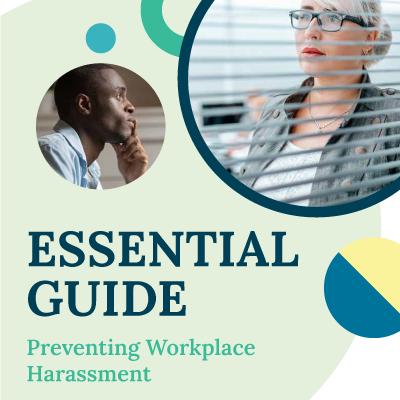SEXUAL HARASSMENT TRAINING
California Sexual Harassment Training and Prevention
Syntrio’s employment law courses comply with California’s mandatory training requirements, from EEOC-compliance guidelines, landmark cases, and sentencing guidelines to applicable federal and state regulations.
The pillars of our harassment training program involve the following:
- Workplace Civility & Respect Training
- Diversity, Equity & Inclusion Training
- Employment Discrimination and Workplace Fairness Training
- California Sexual Harassment Training
- Speak Up and Listen Up Training
Preview the U.S. Workplace Harassment and Discrimination Training Course
California Harassment Training
Welcome to our comprehensive California Harassment Training page. California has established some of the most employee-friendly laws and regulations in the United States when it comes to sexual harassment and discrimination in the workplace. To create a safe and inclusive work environment, employers must not only comply with federal employment law but also be aware of California’s specific requirements for sexual harassment prevention training and workplace harassment training. It’s important to note that California’s employment laws offer greater protections for employees than federal laws do. Understanding workplace harassment laws in California and meeting the state’s sexual harassment training requirements also involves considering the broader scope of federal anti-discrimination law and its impact on California’s sexual harassment laws.
Syntrio’s California U.S. Workplace Harassment and Discrimination Training
- Experienced: Developing workplace harassment training since 2002 and California harassment training since 2005.
- Compliant: Complies with all relevant California regulatory requirements, including abusive conduct and 2021 updates; a course timer ensures learners meet the minimum training time
- Engaging: Engages learners with short, live-action stories and practical exercises.
- Comprehensive: Addresses all required topics plus contemporary issues – workplace relationships, bystander intervention, diversity, equity, and inclusion.
- Flexibility: Versions for managers (2 hrs) and non-managers (1 hr); other versions that incorporate California with additional state training for easier deployment for multi-state businesses.
- Industries: Six industry verticals, including office/general, healthcare, industrial, hospitality, retail, and higher education.
California Sexual Harassment Law
In addition to the illegality of employment discrimination and workplace harassment under federal employment laws, sexual harassment is illegal under the California anti-discrimination and California sexual harassment law, known as the California Fair Employment and Housing Act (“FEHA”). The FEHA is an employment law prohibiting workplace harassment in California and requires employers to conduct California sexual harassment training.
Significantly, sexual harassment in the workplace laws in California differs somewhat from federal anti-discrimination laws. In addition to other protected classes, such as marital status, California enacted a specific Government Code section 12923, which limits the need for misconduct to be “severe and/or pervasive.” Instead, California’s anti-discrimination law only requires “the harassment so altered working conditions as to make it more difficult to do the job.” As such, employers must pay specific attention to California’s sexual harassment law and California’s employment laws to distinguish between federal employment law and federal anti-discrimination law in making choices to fulfill California workplace harassment training and sexual harassment training requirements.
Categories of Workplace Harassment
Under federal and California workplace harassment laws, there are two categories of workplace harassment. They include:
“Hostile Work Environment harassment,” which refers to unwelcome comments or conduct based on sex that is either severe or pervasive such that they unreasonably interfere with an employee’s work performance or create an intimidating, hostile, or offensive work environment that alters the conditions of employment; and
“Quid Pro Quo sexual harassment” occurs when a job or promotion is explicitly or implicitly conditioned on an applicant or employee’s submission to sexual advances or other conduct based on sex.
No matter the type of sexual harassment, workplace sexual harassment is a severe issue in California, and protections extend to applicants, employees, unpaid interns, professional relationships, and independent contractors. Likewise, mandatory training requirements for California workplace harassment training and California sexual harassment training apply to most (if not all) of the workforce in California.

EMPLOYMENT LAW: HARASSMENT AND DISCRIMINATION COURSE
COMPENSATION AND BENEFITS
Meal & Rest Break Training
Understanding the Family Medical Leave Act (FMLA)
Wage & Hour Basics
CORRECTIVE ACTION
Avoiding Wrongful Termination
Employee Discipline
DISCRIMINATION
Employment Discrimination: Maintaining a Fair Workplace
Employment Discrimination: Sex
Employment Discrimination: Race, Color, and National Origin
Employment Discrimination: Religion
Employment Discrimination: Age
Employment Discrimination: Disability
Employment Discrimination: Sexual Orientation and Gender Identity
Creating a Bully-Free Workplace
DISCRIMINATION ETHICAL SNAPSHOTS
Festival Time
The Job Interview
Up or Out
Unpleasant News
An Open Position
HARASSMENT
U.S. Workplace Harassment and Discrimination
Bystander Intervention and Awareness and Sexual Harassment
Bystander Awareness and Intervention for Chicago
Preventing and Addressing Sexual Harassment
Preventing Sexual Harassment
Preventing Workplace Harassment
Workplace Harassment and Bullying: Managing Threats to a Respectful Work Culture
California Preventing Workplace Harassment
Connecticut Sexual Harassment Training for Employees
Delaware Preventing Sexual Harassment
Illinois Preventing Sexual Workplace Harassment
Maine Preventing Sexual Harassment
New York Preventing Sexual Harassment
Campus Aware: Sexual Violence Prevention
Harassment: Ensuring a Respectful Workplace
Preventing Unlawful Harassment for Colleges and Universities
Preventing Unlawful Workplace Harassment for Federal Agencies
Multi-Jurisdiction Preventing Workplace Harassment
Canada Harassment and Violence at Work
U.S. Workplace Harassment - Chicago
SPEAK UP ETHICAL SNAP SHOTS
Speak Up - Feeling Uncomfortable A/B
Speak Up - Harassment A/B
Speak Up - Health and Safety
Speak Up - Offensive Remark A/B
Speak Up - Something Missing
HARASSMENT ETHICAL SNAPSHOTS
The Viral Email
Jack and Dani Went Up a Hill
Third-Party Harassment
Making a Complaint
Making a Complaint 2
The Panda
Talking Sports
Unexpected Consequences
An Open Position
Workplace Disrespect?
A Very Important Client
A Very Important Client (B)
A Very Important Client (C)
Social Tony
Too Close for Comfort (A)
Too Close for Comfort (B)
Bullying
Workplace Harassment
Sexual Harassment
INVESTIGATIONS
RECRUITMENT
Legal Aspects of Interviewing and Hiring
RETALIATION ETHICAL SNAPSHOTS
Retaliation
Rocking the Boat
SUBSTANCE ABUSE
Managing Substance Abuse in the Workplace
ABUSIVE CONDUCT STANDARD
In 2015, California amended its anti-discrimination law to require all California employers subject to the mandatory California sexual harassment training requirement to include a component preventing “abusive conduct.” Notably, the “abusive conduct” (bullying and harassment in the workplace) amendment did not create a new protected category or make abusive conduct illegal; instead, it amended only the training requirement to add a component to mandatory training conducted for compliance with California harassment training requirements.
Under the 2015 change to the California anti-discrimination law, “abusive conduct” is defined as “conduct of an employer or employee in the workplace, with malice, that a reasonable person would find hostile, offensive, and unrelated to an employer’s legitimate business interests.” California’s definition of abusive conduct amounts to bullying and harassment. Still, the state gives examples that abusive conduct may include “repeated infliction of verbal abuse, such as the use of derogatory remarks, insults, and epithets, verbal or physical conduct that a reasonable person would find threatening, intimidating, or humiliating, or the gratuitous sabotage or undermining of a person’s work performance.”
California Sexual Harassment Training Requirements
Since 2006, under the California anti-discrimination law, California employers have been required to provide mandatory anti-harassment training on preventing sexual harassment and sexual harassment and discrimination in the workplace. The California sexual harassment training requirements have evolved in recent years, and obligations for providing California sexual harassment training, discrimination and harassment in the workplace, and bullying and workplace harassment training have increased since 2020.
Under California employment law, all public and private organizations with five or more employees must provide mandatory training on harassment in the workplace (and the prevention of discrimination) at least once every two years. Among those who must receive California harassment training are managers and non-supervisory employees. It is also recommended (but not required) that interns and seasonal employees be provided training on preventing discrimination and harassment in the workplace.
Workplace harassment training in California must have a minimum duration of two hours for supervisory employees and one hour for non-supervisory employees. Records of sexual harassment prevention training must be kept for at least two years. California sexual harassment law requires mandatory training to contain the following categories of information:
- Federal and state employment law statutory provisions and case law concerning the prohibition against sexual harassment in the workplace;
- Examples of conduct that can be considered workplace sexual harassment;
- Remedies and resources available to victims of discrimination and harassment in the workplace;
- Strategies to prevent workplace sexual harassment;
- Supervisor responsibilities to prevent harassment in the workplace;
- A statement of the illegality of employment discrimination;
- Practical examples of workplace sexual harassment based on gender identity, gender expression, and sexual orientation;
- A link to the employer’s sexual harassment policy, which the learner must acknowledge having read;
- Bystander intervention training is encouraged but not required.
In addition to following all California sexual harassment training requirements for the content, employers must have a qualified “trainer” (an attorney, human resources professional, professor or instructor, or workplace harassment prevention consultant) to be available to answer questions about California sexual harassment law and mandatory training content, as well as questions that may generally arise about sexual harassment at work. Trainers must maintain a copy of all inquiries received for two years.
Acceptable Modes of Complying with California Sexual Harassment Training Requirements
California’s anti-discrimination law and implementing regulations identify the acceptable means of providing anti-harassment training. The following are prescribed methods of complying with your obligation to provide sexual harassment prevention training:
- “In-person” California sexual harassment training is offered live by an instructor qualified as described in California employment law;
- “eLearning” training is interactive, computerized training created by a qualified trainer and instructional designer. Importantly, employers who provide this type of workplace harassment training shall instruct employees to contact a qualified California sexual harassment trainer who can answer the question within two days.
- “Webinar” training is an internet-based seminar created and taught by a trainer qualified to provide California harassment training.
- “California’s anti-discrimination regulations describe other interactive training” as “use of audio, video or computer technology in conjunction with classroom, webinar and/or eLearning training. These, however, are additional tools that cannot, by themselves, fulfill the requirements of this subdivision.

STATE-MANDATED HARASSMENT TRAINING REQUIREMENTS
Several states have enacted mandatory training laws that require employers to provide sexual harassment training to their managers and employees.
Click on each state to learn more about Syntrio’s sexual harassment training products dedicated to exceeding compliance with mandatory training laws in each state. You will also learn about the requirements in that particular jurisdiction.
Preview the U.S. Workplace Harassment and Discrimination Training Course

Why Syntrio’s Compliance Training Is Your Best Source for Workplace Harassment Training Laws, Sexual Harassment Training, and Prevention in California
Syntrio has been the leader in workplace harassment training in California for over 20 years.
Since its inception in the anti-discrimination and workplace harassment training market over 20 years ago, Syntrio has been aware that it needs to be different to help employers not only comply with sexual harassment in the workplace laws in California but also to help employers empower their workforce to speak up and make an actual difference in workplace culture. The first harassment training laws were enacted in the early 1990s when Syntrio began developing content intended to assist employers in educating their workforces on employment law, workplace harassment, and employment discrimination (including in California). Following California’s harassment training mandate in the mid-2000s, there was an explosion of activity in this area as organizations scrambled to find “check the box” compliance training (mainly to bolster defense in the event litigation commenced) or no training at all.
The Syntrio approach to California Bullying and Harassment in the Workplace Training is Different.
While the drive to provide workplace harassment training has not changed, expert views on the type and focus of training have. Many of our competitors continue to provide “check the box” California sexual harassment training that was primarily provided before the #MeToo era and aimed at combating the harmful effects of an incident of harassment in the workplace. This workplace harassment training focused on illegal sexual harassment and how companies could avoid liability rather than actual incident prevention and improve workplace culture. Syntrio knows legalistic, compliance-focused training does not resonate with employees and has researched what works.
The solutions that help to improve workplace culture and help reduce the number of incidents of workplace harassment involve a full-scale program of civility and respect training. It is essential to provide training that complies with California sexual harassment law. Still, it is also necessary to let your workforce know that you care about their well-being. Therefore, a speak up and listen up a program aimed at empowering your workforce to report incidents is a critical aspect of any California sexual harassment training program. Additionally, employers must provide training that teaches employees to respect one another and demonstrates the organization’s respect for its workforce. In addition to understanding what illegal sexual harassment is, employees must understand one another’s sensitivities and the organization’s understanding that everyone has individual needs.
Syntrio Continues to Innovate
As the 2010s closed, significant legislation and legislative recommendation left nearly half of the United States under a mandate or official guidance that some or all employees receive sexual harassment training. Although this increase was expected to continue, the pandemic slowed legislative development in this area. Nevertheless, Syntrio continued forging a new method of helping employers comply with California sexual harassment training requirements and uses its depth of knowledge and expertise in the area to set itself apart from the competition by providing depth and breadth of employment law training that is cohesive as a component of an overall training strategy aimed at cultural improvement for the benefit of the employee.





